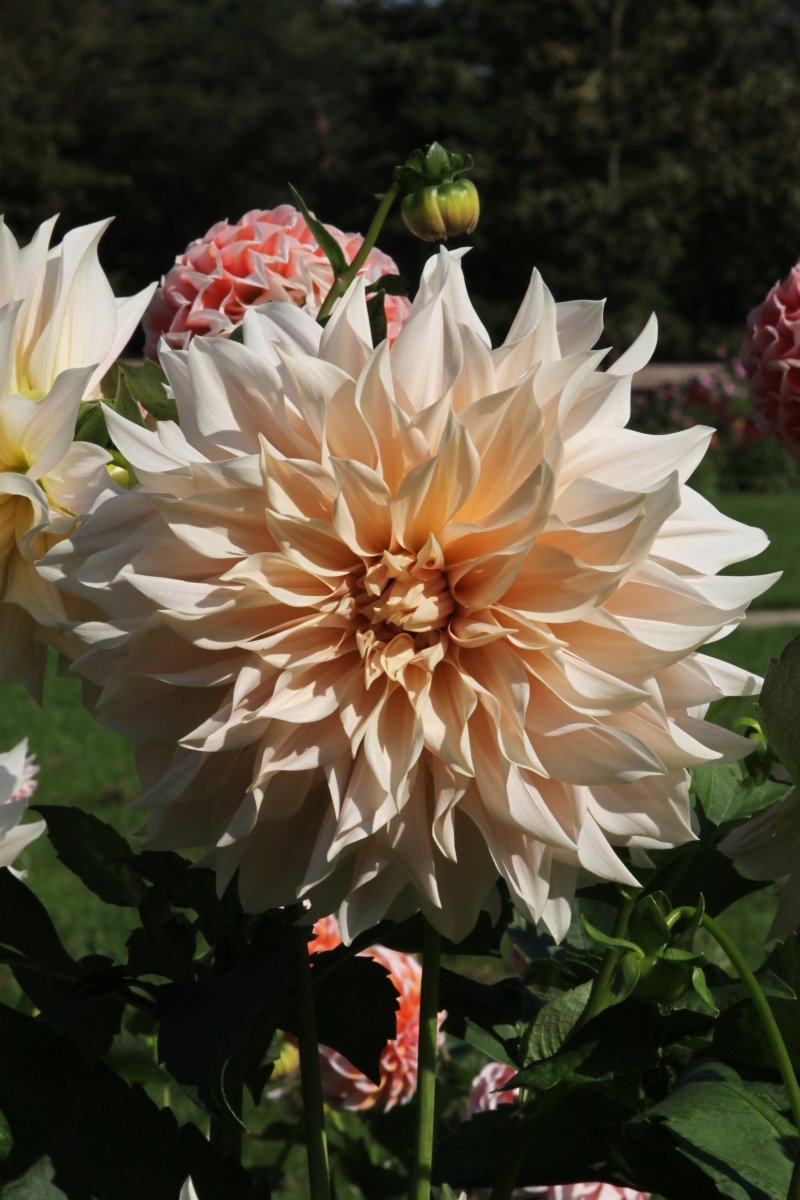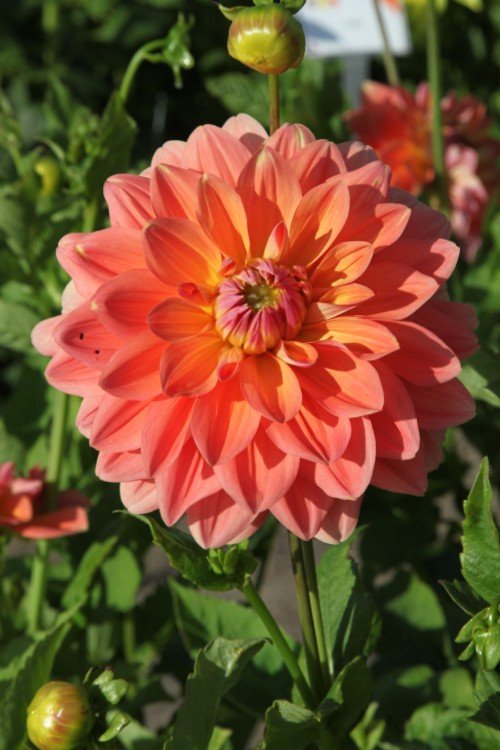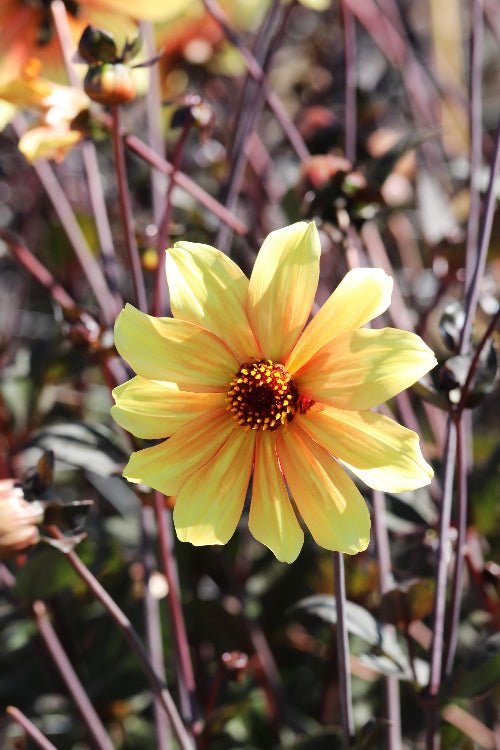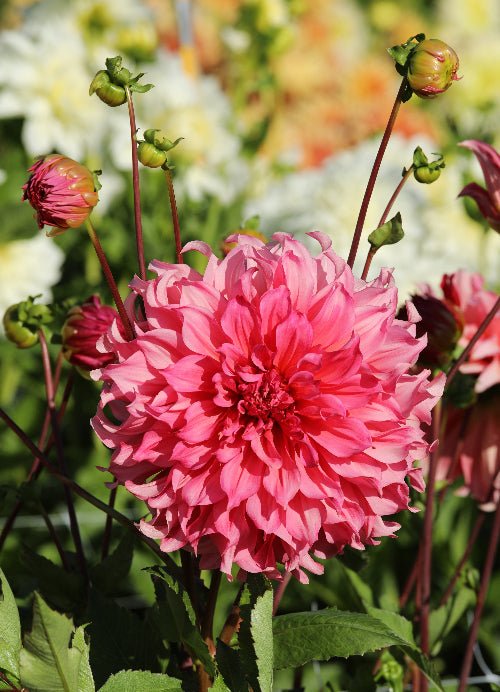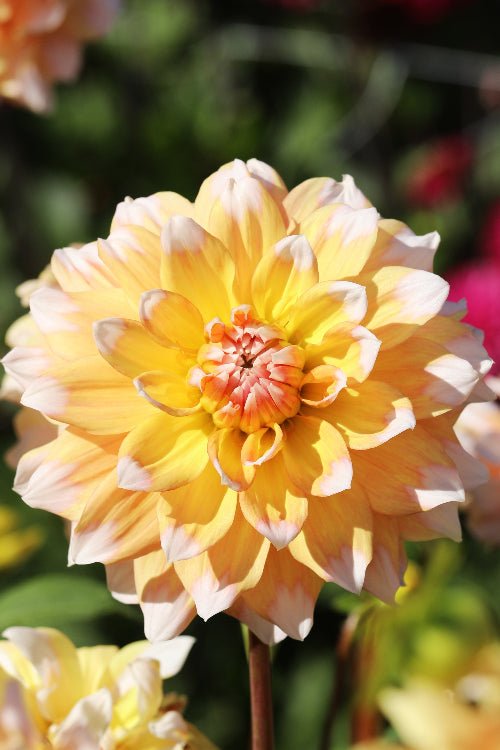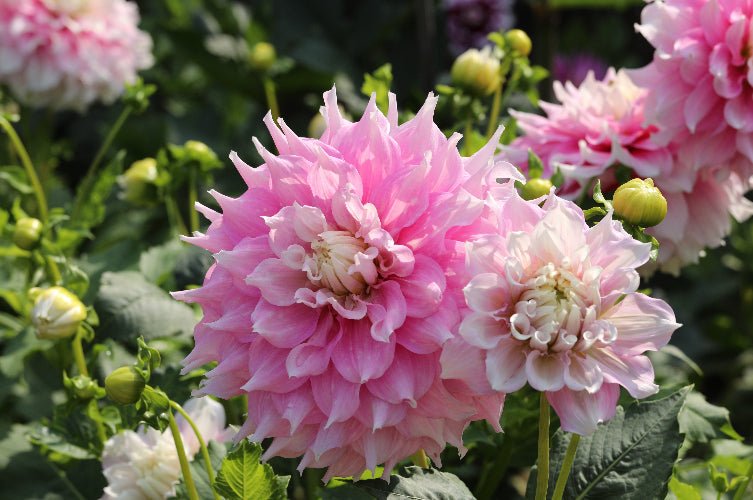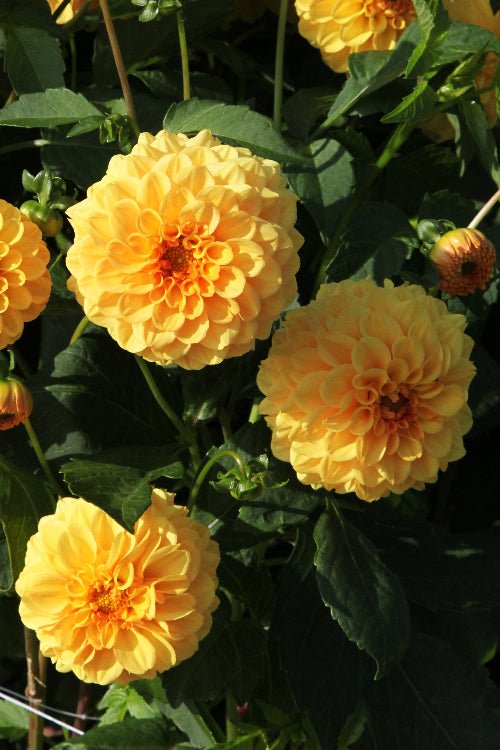Explore our collection of Dahlia bulbs
Sort by:
About Café au Lait Dahlia
The Café au Lait Dahlia is a stunning addition to any garden. Its large, fluffy blooms in shades of light pink, light yellow and white will add a touch of elegance to any landscape. This beautiful perennial plant is easy to grow and will bloom from late summer until the first frost.
- Large, fluffy blooms in shades of light pink, light yellow and white
- Easy to grow and hardy perennial
- Blooms from late summer until the first frost
- Perfect addition to any garden or landscape
- Ideal for cut flowers
- Height 40" and spread 20"
- Huge 10" blossom heads
How to plant and take care of Dahlia Café Au Lait
- Simply plant the tubers in a sunny spot
- Make sure to use well-draining soil
- Water them thoroughly
- Fertilize them every 2-4 weeks
- Deadhead spent blooms
About Peaches and Cream
Dahlia Peaches and Cream is an eye-catching, easy-to-grow bulb that will add an exciting splash of color to your garden. Peaches and Cream offers a profusion of soft yellow petals flamed with orangery red and tipped with white.
- Introduce a vibrant touch of peachy pink, soft orange and cream to your outdoor space with this delightful flower
- Bright and colorful flowers with a bold two-tone pattern
- Easy to grow for long-lasting blooms
- Positively impacts pollinators
- Great for outdoor garden beds and containers
- Has flowers that are 5-6'' in diameter
How to care for Peaches and Cream
- Choose a sunny spot in your garden, preferably without wind
- Dig a hole in well-draining soil and place the tuber with the eyes facing up.
- Cover with soil, don’t bury it, and water well.
- The dahlia will begin to sprout within a few weeks. For optimal growth and blooming, ensure the dahlia receives at least 6 hours of sunlight per day and is regularly watered.
About Rip City
The Rip City Dahlia is a must-have for any flower enthusiast. This unique and vibrant flower is sure to add a pop of color to any garden. Rip City is a very dark maroon small decorative Dahlia with a velvety black center, for sure a showstopper!
- Large blooms with very dark maroon dahlias
- Perfect for adding a pop of color to any garden
- Easy to grow and maintain
- Long-lasting blooms throughout the summer
- Great for cut flowers
- A very prolific flowering dahlia and makes a robust and bushy plant
How to care for Rip City
- To plant, simply dig a hole in well-drained soil and place the tuber with the 'eye' facing up.
- Cover with soil and water well.
- Dahlia Rip City prefers full sun and regular watering.
- Deadhead spent blooms to encourage continued flowering throughout the season.
About Emory Paul
The Dahlia tuber Emory Paul is a stunning addition to any garden. With its large, dark pink blooms and tall stature, it's sure to make a statement in any garden bed or container. This tuber is easy to grow and maintain, making it a great choice for both experienced and novice gardeners.
- Large, dark pink blooms
- Tall stature for a statement-making look
- Easy to grow and maintain
- Perfect for both experienced and novice gardeners
- Produces huge flower heads up to 13" in diameter
- Can be planted in a garden border or in patio pots and containers.
- Perfect for cut flower
How to take care of Emory Paul?
- Pick the sunniest location in your garden or patio.
- Plant it in well-drained soil.
- Water regularly.
- Fertilize every 4-6 weeks with a balanced fertilizer.
- Deadhead spent blooms to encourage new growth.
About Fleurel
Dahlia Fleurel is the ideal addition to any garden. With its large, vibrant blooms and long-lasting blooming period, it is sure to make a statement in any space. Make your garden come alive and bring a splash of color with the Dinnerplate Dahlia Fleurel.
- Large, showy blooms in shades of white and cream
- Long blooming period from summer to fall
- Easy to grow and maintain
- Ideal for borders, beds, and cut flowers
- Ships as a bare root tuber ready for planting
- Has flowers over 10" big
How to care for Fleurel?
- To plant your Dahlia tuber Fleurel, simply find a sunny spot in your garden with well-draining soil.
- Plant the tuber with the "eye" facing up, about 4-5 inches deep, and water well.
- Once the plant has sprouted and grown a few inches, you can start to fertilize it every 4-6 weeks.
- Be sure to keep the soil consistently moist but not waterlogged.
- Deadhead the flowers regularly to encourage continuous blooming.
About Ace Summer Sunset Dahlia
The Dahlia Ace Summer Sunset is a stunning and vibrant addition to any garden. This Dinnerplate Dahlia is a true showstopper, with large and bright blooms in a range of coral pink, orange and yellow hues. Perfect for adding a pop of color to any garden or landscape, this dahlia is sure to turn heads.
- The whole summer long a small ‘summer sunset’ in your garden
- Large and bright blooms in a range of coral pink, orange and yellow hues
- A sturdy and hardy plant that can withstand varying weather conditions
- Perfect for adding a pop of color to any garden or landscape
- Easy to plant and maintain, making it perfect for both experienced and novice gardeners
- Ships as a tuber, ready to be planted in the spring for a beautiful summer display
- Grows up to 38-40'' tall
- Has huge-sized blossoms of 8''
How to care for your Dahlia Ace Summer Sunset
- Plant it in well-drained soil in an area that receives full sun
- Water regularly, making sure not to overwater
- Deadhead spent blooms to encourage reblooming
- In fall, when the leaves have turned yellow, dig up the tubers, clean them off and store them in a cool, dry place until spring
About Bishop of York
The Dahlia Bishop of York is a must-have for any flower gardener. With its stunning yellow petals, it is sure to add a splash of color to any garden.
- Easy to grow and maintain
- Perfect for cut flowers and borders
- Large, showy blooms
- Tall, sturdy stems
- Blooms all summer long
- Attracts many butterflies
How to plant and care for Bishop of York
- Start by selecting a sunny spot in your garden with well-drained soil
- Plant the tubers about 3-4 inches deep and 18 inches apart
- Water regularly
- Fertilize with a balanced fertilizer every 2-4 weeks
- Deadhead spent blooms to encourage new growth
About Islander
Discover the captivating Dinnerplate Dahlia Islander: its stunning, fiery pink blooms are sure to make a statement in any landscape.
- This beautiful and unique flower is sure to bring life and color to any garden
- It features rich, deep pink petals with a dark pink center
- It's an excellent choice for landscape edging and cutting gardens
- Easy to plant and requires minimal care
- Flower size of 10"
How to care for Islander
- When planting Dahlia Islander, it is important to choose a spot with well-drained soil and full sun.
- Plant the tuber about 4-5 inches deep and 18 inches apart.
- Water regularly, and fertilize every 4-6 weeks during the growing season.
- As the blooms begin to fade, cut them off to encourage new growth.
About Seattle
Dahlia Seattle: get ready for a stunning addition to your garden! This beautiful flower is known for its vibrant colors and large blooms, making it a perfect choice for any gardener. This Dinnerplate Dahlia features huge and magnificent golden yellow flowers with white tips.
- Vibrant colors and large blooms
- Easy to grow and maintain
- Perfect for any gardener, from beginner to experienced
- High-quality, healthy tubers
- Has impressive fully double flowers up to 6-8 inches wide
How to care for Seattle
- To plant your Dahlia Seattle, simply find a sunny spot in your garden and dig a hole that is twice the size of the tuber.
- Place the tuber in the hole with the pointy side facing up, and cover it with soil.
- Water well and continue to water regularly until established.
- Make sure to keep the soil consistently moist and fertilize regularly.
- Deadhead the flowers to encourage continued blooming.
- In the fall, cut back the stems to the ground and dig up the tubers to store for the winter.
About Mick’s Peppermint
Discover the Cactus Dahlia Mick's Peppermint - a unique and beautiful flower that is perfect for any garden. These unusual spiky flowers are a delightful sight in the summer border where they will catch the interest and act as a focal point of the summer bulb display.
- Delicate, white petals (sometimes very light pink) with a dark magenta center and magenta spickles, make it a standout visual statement
- A breathtaking and fragrant combination of silky, soft petals
- Easy-to-grow flower with a long blooming season.
- Stunning texture and fragrance
- Unique visual statement
- Create a stunning display in your garden or flowerbed with this eye-catching bloom.
- Grows up to a height of 48"
- Produces fully double-pointed petals which turn backward to create a tubular effect
How to care for Mick’s Peppermint
- Dig a hole that is slightly deeper than the tubers and space them about 24 inches apart. Water well and keep the soil moist until the plants are established.
- Once they are established, you can reduce the amount of water.
- To care for Mick's Peppermint Dahlia, it is important to keep the soil consistently moist, but not waterlogged.
- Deadhead the flowers regularly to encourage more blooms.
- Cut the plant down to the ground in the fall to prepare it for the next growing season.
About Autumn Fairy
The Dahlia Autumn Fairy will add a splash of color to any landscape or garden. With its unique deep orange, coral-pink hue, amazing multi-layered petals, and fluffy blooms, you can expect a truly spectacular display of vibrant summer colors
- Unique deep orange, coral-pink hue with a touch of yellow
- Multi-layered petals for an impressive display
- Fluffy blooms for added texture
- Perfect for adding some summer colors to your landscape
- They can reach up to 6'' in diameter, making them a stunning focal point
- Easy to grow and care for, making it a great option for both experienced and starting gardeners
How to care for your Autumn Fairy
- Plant it in well-draining soil in a sunny spot
- Water regularly and fertilize every 2-4 weeks
- Deadhead spent blooms to encourage more flowers to form
- In the fall, cut back the stems and dig up the tubers to store them in a cool, dry place over the winter
About Ferncliff Illusion
Dahlia 'Ferncliff Illusion' is a gorgeous and vibrant flowering Dahlia that blooms with showy double blooms in an array of colors. Perfect for borders, beds, bouquets, or containers.
- Beautiful double-white blooms with lavender tips
- Perfect for borders, beds, bouquets, or containers
- Highly tolerant of drought conditions
- Low maintenance
- Long-blooming annual plant
- Excellent as cut flower
How to care for Ferncliff Illusion
- Be sure to plant it in a sunny location with well-draining soil.
- Water regularly (especially right after you plant the dahlia tuber).
- Fertilize every few weeks for optimal growth and blooming.
- Deadhead spent blooms to encourage continued flowering.
About Maki
Introducing the Dinnerplate Dahlia Maki! Looking for a stunning, low-maintenance flower that will brighten up any garden? Look no further than the Dahlia Maki! This hardy, easy-to-grow flower produces large, vibrant blooms in shades of pink, purple, and white.
- Perfect for adding color and texture to any garden or landscape
- Low maintenance, easy to grow and care for
- Produces large, vibrant blooms in a variety of colors
- Long-lasting blooms that will last all summer long
- Great for cutting and adding to floral arrangements
- Produces huge blooms
- Grows up to a height of 36-36 inches
How to care for Maki
- Dig a hole in well-draining soil and place the tuber with the "eye" facing up.
- Cover with soil and water thoroughly.
- Make sure they get at least 6 hours of sunlight every day.
- Fertilize every 2-4 weeks.
- To ensure a long-lasting blooming season, deadhead the flowers as they begin to fade.
About Caribbean Fantasy
The Dahlia Caribbean Fantasy is a beautiful and unique flower that is sure to make a statement in any garden. With its vibrant colors and unique shape, this Dahlia will bring a touch of tropical paradise to any space.
- Bright, tropical colors of pink, orange, yellow and white
- Unique, ruffled petals
- Great for adding a pop of color to any garden or landscape
- Easy to grow and maintain
- Plant in full sun
- The blossoms open up to 5" across
How to care for Caribbean Fantasy
- Pick a nice sunny spot in your garden or patio
- Simply place the tuber in well-drained soil and cover it with 2 inches of soil.
- Water regularly and fertilize every 2-4 weeks to promote healthy growth and abundant blooms.
- Be sure to stake taller varieties to prevent damage from wind or heavy rain.
- Remove any spent or wilted blooms
About Gitt’s Perfection
The Gitt's Perfection Dahlia is a stunning and unique variety of flowers that is sure to add color and beauty to any garden or floral arrangement. With its large, vibrant blooms and long-lasting blooming season, this tuber is the perfect addition to any garden.
- Large, vibrant blooms that can reach up to 8 inches in diameter
- A long-lasting blooming season that lasts from mid-summer to fall
- Perfect for adding color and beauty to any garden or floral arrangement
- Easy to grow and maintain
- Resistant to pests and disease
- Soft pale pink flower blending to a white center
How to plant and take care of Gitt's Perfection
- Plant tubers in well-draining soil in a sunny spot after the last frost date
- Space tubers about 24 inches apart and cover with 2-3 inches of soil
- Water regularly and fertilize every 4-6 weeks
- Deadhead spent blooms to encourage more flowers
About Vancouver
Looking for a stunning addition to your garden? Look no further than the Decorative Dahlia Vancouver. This beautiful flower is sure to add color and beauty to any space.
- Large, vibrant blooms in shades of fuchsia, red, and purple with white edging
- Easy to grow and maintain, making it perfect for both experienced and beginner gardeners
- Long blooming season from summer to fall
- Can be planted in pots or in the ground
- Hardy and drought-tolerant
- Large blooms (some up to 8" across!)
- Will grow to a max height of around 3 feet
How to care for Vancouver
- Plant the tubers in well-draining soil in a sunny location.
- Cover with 2-3 inches of soil and water well.
- Once the plants reach about 6 inches tall, begin staking them to prevent falling over.
- Water regularly, keeping the soil consistently moist but not soggy.
- Deadhead the blooms regularly to encourage more blooms to appear.
About Bishop of Auckland
Introduce your garden to the heavenly Dahlia Bishop of Auckland! With its eye-catching tones of dark red hues, stunning flower will surely captivate any onlooker.
- Long-lasting, bright blooms
- Special tones of dark red hues
- Excellent cut flowers
- Guaranteed to add beauty to any garden
- Provides long-lasting color
- Attracts many butterflies
- Strong, sturdy stems that can reach up to 3 feet tall
How to plant and take care of Bishop of Auckland?
- Place the tuber in a hole about 3-4 inches deep and 18 inches wide, with the eyes facing up.
- Cover with soil and water well.
- The plant prefers full sun and well-drained soil.
- Keep the soil consistently moist, but not waterlogged.
- Deadhead spent blooms to encourage continued flowering.
About Golden Scepter
Brighten up your garden with the stunning Dahlia tuber Golden Scepter! With fabulous canary yellow, double spherical blooms, these Golden Scepter dahlias are sure to add a new dimension of shape and texture to any garden. Each flower head is made up of layers of silky, inwardly curved petals creating a perfectly formed sphere.
- Unique, eye-catching yellow and golden petals.
- Stems up to 6 feet tall.
- Attractive double blooms in late summer and early fall.
- Tall, sturdy stems which not only provide excellent support but also provide the dahlia with its iconic bobbing habit in the breeze.
How to take care of Golden Scepter
- To plant the Dahlia Golden Scepter, simply place the tuber in well-draining soil in a sunny location.
- Water well and keep the soil consistently moist until the plant begins to sprout.
- Once the plant is established, water as needed and fertilize regularly for optimal growth and blooming.
- Deadhead spent blooms to encourage more flowers to form
FAQs

